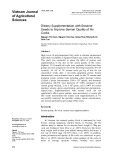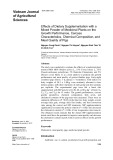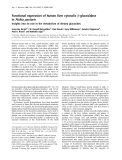
Dietary assessment
-
High levels of polyunsaturated fatty acids in chicken spermatozoa make them susceptible to lipoperoxidation and reduce their fertility. This study was conducted to assess the effect of sesame seed suplementation in the diet on the semen quality of Ho cocks.
 11p
11p  vibecca
vibecca
 01-10-2024
01-10-2024
 1
1
 0
0
 Download
Download
-
The present study aimed to assess the growth performance, meat composition, carcass parameters, and meat quality of grower-finisher pigs fed long-term diets supplemented with increasing levels of medicinal plant mixtures (Ramulus Cinnamomi, star anise, B. pilosa, U. lobata, and P. palatiferum).
 11p
11p  vibecca
vibecca
 01-10-2024
01-10-2024
 2
2
 1
1
 Download
Download
-
To investigate of nutritional status in maintenance hemodialysis patients by indicators: anthropometric, dietary energy, and protein intake, dialysis malnutrition score, serum albumin, prealbumin levels. To Understand the relationship between nutritional status and some clinical and laboratory characteristics, initially assessing the results of an oral nutritional supplement on nutritional status in 12 weeks in maintenance hemodialysis patients.
 24p
24p  angicungduoc6
angicungduoc6
 21-07-2020
21-07-2020
 22
22
 2
2
 Download
Download
-
Human tissues such as liver, small intestine, spleen and kidney contain a cytosolic b-glucosidase (CBG) that hydrolyses variousb-D-glycosides, but whose physiological function is not known. Here, we describe the ®rst hetero-logous expression of human CBG, a system that facili-tated a detailed assessment of the enzyme speci®city towards dietary glycosides.
 10p
10p  research12
research12
 29-04-2013
29-04-2013
 47
47
 3
3
 Download
Download
-
Nutritional Status Assessment Full nutritional status assessment is reserved for seriously ill patients and those at very high nutritional risk when the cause of malnutrition is still uncertain after initial clinical evaluation and dietary assessment. It involves multiple dimensions, including documentation of dietary intake, anthropometric measurements, biochemical measurements of blood and urine, clinical examination, health history, and functional status. For further discussion of nutritional assessment, see Chap. 72.
 4p
4p  konheokonmummim
konheokonmummim
 03-12-2010
03-12-2010
 81
81
 5
5
 Download
Download
-
Acute Care Settings Acute care settings, anorexia, various diseases, test procedures, and medications can compromise dietary intake. Under such circumstances, the goal is to identify and avoid inadequate intake and ensure appropriate alimentation. Dietary assessment focuses on what patients are currently eating, whether they are able and willing to eat, and whether they experience any problems with eating. Dietary intake assessment is based on information from observed intakes; medical record; history; clinical examination; and anthropometric, biochemical, and functional status.
 7p
7p  konheokonmummim
konheokonmummim
 03-12-2010
03-12-2010
 81
81
 4
4
 Download
Download
-
Physiologic Factors Growth, strenuous physical activity, pregnancy, and lactation increase needs for energy and several essential nutrients, including water. Energy needs rise during pregnancy, due to the demands of fetal growth, and during lactation, because of the increased energy required for milk production. Energy needs decrease with loss of lean body mass, the major determinant of REE. Because both health and physical activity tend to decline with age, energy needs in older persons, especially those over 70, tend to be less than those of younger persons.
 5p
5p  konheokonmummim
konheokonmummim
 03-12-2010
03-12-2010
 73
73
 4
4
 Download
Download
-
Estimated Average Requirement When florid manifestations of the classic dietary deficiency diseases such as rickets, scurvy, xerophthalmia, and protein-calorie malnutrition were common, nutrient adequacy was inferred from the absence of their clinical signs. Later, it was determined that biochemical and other changes were evident long before the clinical deficiency became apparent. Consequently, criteria of nutrient adequacy are now based on biologic markers when they are available.
 5p
5p  konheokonmummim
konheokonmummim
 03-12-2010
03-12-2010
 71
71
 4
4
 Download
Download
-
Note: This table presents recommended dietary allowances (RDAs) in bold type and adequate intakes (AIs) in ordinary type. RDAs and AIs may both be used as goals for individual intake. RDAs are set to meet the needs of almost all individuals (97 to 98%) in a group. For healthy breastfed infants, the AI is the mean intake. The AI for other life stage and gender groups is believed to cover needs of all individuals in the group, but lack of data or uncertainty in the data prevent being able to specify with confidence the percentage of individuals covered by...
 9p
9p  konheokonmummim
konheokonmummim
 03-12-2010
03-12-2010
 85
85
 4
4
 Download
Download
-
Water For adults, 1.0–1.5 mL water per kcal of energy expenditure is sufficient under usual conditions to allow for normal variations in physical activity, sweating, and solute load of the diet. Water losses include 50–100 mL/d in the feces, 500–1000 mL/d by evaporation or exhalation, and, depending on the renal solute load, ≥1000 mL/d in the urine. If external losses increase, intakes must increase accordingly to avoid underhydration. Fever increases water losses by approximately 200 mL/d per °C; diarrheal losses vary but may be as great as 5 L/d with severe diarrhea.
 8p
8p  konheokonmummim
konheokonmummim
 03-12-2010
03-12-2010
 77
77
 5
5
 Download
Download
-
Harrison's Internal Medicine Chapter 70. Nutritional Requirements and Dietary Assessment Nutritional Requirements and Dietary Assessment: Introduction Nutrients are substances that must be supplied by the diet because they are not synthesized in the body in sufficient amounts. Nutrient requirements for groups of healthy persons have been determined experimentally. For good health we require energy-providing nutrients (protein, fat, and carbohydrate), vitamins, minerals, and water.
 5p
5p  konheokonmummim
konheokonmummim
 03-12-2010
03-12-2010
 90
90
 8
8
 Download
Download
-
Correction of blood lipid abnormalities offers scope for a major impact on cardiovascular disease. Drugs play a significant role and have a variety of modes of action. Dietary and lifestyle adjustment are components of overall risk prevention.
 8p
8p  bigbaby87
bigbaby87
 03-09-2010
03-09-2010
 79
79
 10
10
 Download
Download
CHỦ ĐỀ BẠN MUỐN TÌM
























